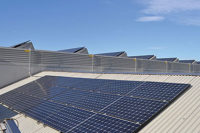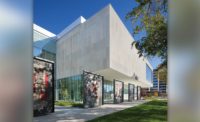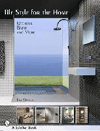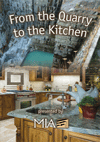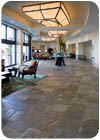
Over
60,000 square feet of quartzite from SpecCeramics was selected for the
high-traffic public areas of the recently renovated Newport Beach Marriott
Hotel & Spa in California. Designer: Hirsh Bedner Associates, Los Angeles, CA; Stone
Supplier: SpecCeramics, Anaheim, CA; Stone Installer: Corradini Corp., Los
Angeles, CA.

The
quartzite - utilized in 16- x 16-inch tiles - was selected for its density and
to add a variegated, rustic look to the space.
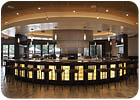
Natural
stone was utilized throughout Plate Restaurant in Wyncote, PA, to help create a
sophisticated, yet casual dining experience.
One of the main highlights of the restaurant is an illuminated
elliptical bar, which has countertops of Absolute Black granite. In addition, Chinese slate was used as a
boundary to help define the bar area from the surrounding dining spaces. Architect: JK Roller, Philadelphia, PA;
Stone Supplier: D.L. Marble and Granite Inc., Queens, NY; General Contractor:
Eastco Contractors Co. Inc., New York, NY
Furthermore, the use of high-density materials such as limestone, quartzite and porcelain tile can offer durability for high-traffic areas such as entryways and exits, as well as hallways and lobbies. Ease of maintenance and slip-resistant qualities are also important factors to consider when deciding on materials.
The use of stone and tile can also aid in creating a specific mood that the clients wish to evoke. For example, glass mosaics can add shimmer and sparkle to liven up a space, while black granite often exemplifies a sense of class and sophistication.
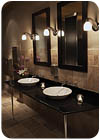
A 1
1/4-inch-thick Absolute Black granite slab was also fabricated for the
countertops of the bathroom vanities.
“The earth tones of the wall tile and 12- x 12-inch stone tile flooring
help to tie everything together,” said the architect. Koenig describes the
Chinese slate as having multiple colors, including tans, blues, purples and
dark browns, which he feels add to the charm of the material.
Reflecting a Coastal Setting
Hirsch Bedner Associates (HBA) recently completed a $70 million renovation at the Newport Beach Marriott Hotel & Spa in California. Calvin Dix, a senior associate with the firm, was in charge of the design and selected a palette of earth-toned colors to enhance the surrounding coastal setting, and quartzite was utilized as flooring throughout most of the public spaces.Over 60,000 square feet of quartzite from SpecCeramics was selected for the high-traffic areas due to its high density, easy maintenance and slip-resistant qualities. The material - utilized in 16- x 16-inch tiles - was selected at the client’s request to add a variegated, rustic look to the space.
Corradini Corp. of Los Angeles, CA, was in charge of the installation. Due to the quartzite’s natural cleft, some tiles were thicker than others, and therefore the installers had to use a deeper-than-usual mortar bed to form a continuity along the plain of the surface.
Additionally, SpecCeramics supplied a variety of porcelain tiles for the guestrooms, including 4 1/4- x 4 1/4-inch porcelain tiles for the bathtub wall areas, 6- x 6-inch tiles for the bathroom floors and 12- x 12-inch pieces for the kitchen floors. Brazilian Ubatuba granite countertops and bar tops can also be found throughout the hotel, and were supplied by SpecCeramics as well.
“We are very pleased with this project,” said Dave Leal, president of SpecCeramics. “We wanted the Newport Beach Marriott Hotel & Spa to be a ‘signature project’ for our firm - one that exemplified progressive design and specification of both natural stone and porcelain tile materials. By all means, this was a world-class project that more than exceeded our highest expectations.”
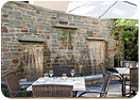
The
outdoor dining area includes a stone waterfall feature comprised of
random-sized sandstone pieces.
Furthermore, Chinese slate was used as an accent feature in the design
of the waterfall and for the seating ledge at the bottom of the reflecting
pool.
Casual, Sophisticated Dining
Stone was also utilized for Plate Restaurant in Wyncote, PA, which was designed by JK Roller Architects of Philadelphia. As part of the overall transformation of the Cedarbrook Hills apartment complex, the 180-seat restaurant was designed to appeal to new young professional residents. Natural light, a sense of openness and casual, yet sophisticated dining were three main goals the architects had in mind when establishing the commercial space.“The goal was to create a sophisticated, yet casual restaurant within the confines of an existing dark and uninviting lower level tenant space,” explained principal architect Matt Koenig of JK Roller Architects.
Chinese slate from D.L. Marble and Granite Inc. of Queens, NY, was used as flooring throughout various spaces of the restaurant. “The owner asked for something to complement the other finishes such as stained concrete in the lobby and surrounding high traffic areas, and for a material that would be easy to maintain,” the architect explained, adding that the owner had previously used the Chinese slate and liked the look of the stone.
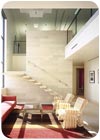
Limestone
was recently selected for the design of the Escobedo Construction offices in
Buda, TX. Light-gray Antique Lueders
limestone from Continental Cut Stone of Florence, TX, was utilized for flooring
throughout the office space, and the same material was also used on the walls
and for the main stairwell.
Additionally, the baseboard features Cedar Hill Cream limestone from
TexasStone Quarries of Garden City, TX. Designer/Contractor: Escobedo
Construction, Buda, TX; Stone Suppliers: TexaStone Quarries, Garden City, TX
(Cedar Hill Cream limestone); Continental Cut Stone, Florence, TX (Antique
Lueders limestone)
Furthermore, Black Absolute granite in a 1 1/4-inch-thick slab was used for the main pick-up line and drink rail in the kitchen. “Black Absolute was chosen for its clean look and tightness of aggregate,” Koenig said.
Stone materials were also carried into an outdoor dining area where random-sized sandstone pieces were installed to form a waterfall feature. Chinese slate was used as an accent feature in the design of the waterfall and for the seating ledge at the bottom of the reflecting pool, the architect explained.
An additional 1 1/4-inch-thick slab of Absolute Black granite was used on the vanity tops in the restrooms. “The Kohler white porcelain bowls provide a stunning contrast with the black granite countertop,” said Koenig. “The earth tones of the wall tile and 12- x 12-inch stone tile flooring help to tie everything together.”
According to Koenig, the stone materials provide a feeling of quality to the restaurant. “The stone helps make the restaurant feel more expensive and raises expectations in terms of the food that may be prepared,” he said. “Recently, stone countertops have become an industry standard for all apartment and condominium projects, where five years ago, we were doing a lot more plastic laminate or Corian.”
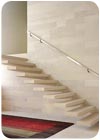
The
materials used throughout the space were selected based on color and structural
integrity, according to company owner David Escobedo.
An Exhibition in Stone
When the owners of Escobedo Construction, a general contracting company, decided to renovate its office building in Buda, TX, the natural choice was to select stone as a finishing material throughout the space. The building, which houses 6,000 square feet of office space, as well as a 22,000-square-foot manufacturing facility, features a variety of natural-colored limestone throughout.According to company owner David Escobedo, the overall goal of the project was “to provide a quality interior finish for client presentations; a stone mill to house our stone production facility, a steel fabrication shop to house our steel fabrication facility and to provide offices for our staff.”
In order to meet the desired aesthetic, limestone was selected for various interior elements, and each material was chosen for its color and structural integrity. Approximately 2,500 square feet of light-gray Antique Lueders limestone from Continental Cut Stone of Florence, TX, was utilized for flooring throughout the office space, and the same material was also used on the walls and for the main stairwell. Additionally, the baseboard running throughout the space, as well as the kitchen countertop, feature Cedar Hill Cream limestone from TexasStone Quarries of Garden City, TX.
According to Escobedo, stone played an integral role in the design, as it exemplified the type of work the company could complete for its clients. “We are a unique masonry contractor, as well as a general contractor, and use our facility to demonstrate our masonry abilities,” he said.
Lately, the designer has noticed that the use of natural face roughbacks for exterior work has increased. “We have done several structures with load-bearing stone construction,” he said, adding that the use of natural face roughbacks instead of chopped stone exteriors has also changed over the past few years.
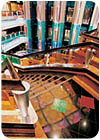
Various-colored
mosaic tiles - from Trend’s Karma collection - were utilized for the design of
the Carnival Cruise lines’ “Fun Ship” Carnival Glory. Architect: Joseph Farcus Architect, P.A., Miami Beach, FL; Tile
Manufacturer: Trend USA, Miami, FL
Colorful Mosaics
Each public room of the Carnival Cruise lines’ “Fun Ship” Carnival Glory celebrates a different shade of the rainbow. At the clients’ request to keep maintenance costs down and the appearance of newness and cleanliness up, architect Joseph Farcus utilized a variety of colored glass mosaic tiles from Trend’s Karma collection to capture most of the colors used throughout the ship.“In a project like this, the idea for me is to create a variety of feelings throughout, like an ‘interesting city,’ as it were,” explained Farcus. “I build a ship design around what I call the Central Idea, which is an intellectual point to build the various and diverse designs around. In the case of the Glory, the idea was ‘Colors,’ so that each public room took its design from a particular color. The atrium, promenade and stairs were all colors of the spectrum.”
The variety of colors begins in the lobby, where one can find the Color Bar and the main atrium, named Old Glory. Enhancing the ship’s Kaleidoscope Boulevard promenade, as well as the atrium, are 1-square-meter polished aluminum light fixtures faced with white glass with internal color changing LED lighting creating infinite color patterns constantly changing, according to the architect.
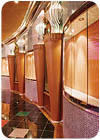
Glass
tiles were particularly important to the design of the ship, as Farcus wanted
to emit a transparent, but colorful feeling for the space.
“Glass tiles were particularly important, as I wanted a transparent, but colorful feeling that could be achieved with tile,” the architect explained. “I worked with Trend to design a new type of affordable tile which had this transparency, but also had a mirror-like reflective quality. That tile is now part of the Trend line called Karma.
“When I design, I think of the feeling I’m trying to achieve, which is going to be the experience of the guests,” he continued. “The design process develops with forms first, then the application of generic materials. Then, the final materials are selected when we write the specs. The particular varieties of stone and tile are determined at this time.”
